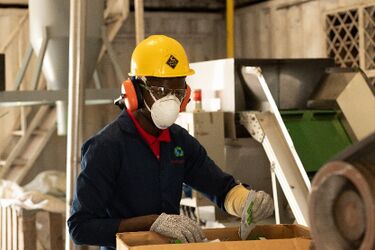Status of e-waste at Kenya’s Kakuma and Kalobeyei Refugee Settlements
In Kakuma and Kalobeyei refugee settlements in Turkana County, the influx of electronic devices such as solar panels and mobile phones, has brought both significant benefits but also a growing issue of electronic waste (e-waste). A recent report based on a scoping study on the status of e-waste in Kakuma and Kalobeyei underscores the need for effective e-waste management in these settlements to address the associated health and environmental risks that may occur in the near future. According to the study’s findings, many users in the two settlements and nearby towns do not give a second thought as to how they dispose of their electronics when they are no longer in use
The study was undertaken by GIZ Kenya in partnership with the Netherlands Development Organization (SNV) and the Waste in Electrical and Electronic Equipment (WEEE) Centre under the Energy Solutions for Displacement Settings (ESDS) project which is part of the German Federal Ministry for Economic Cooperation and Development (BMZ) globally commissioned programme Support to UNHCR in facilitating the operationalisation of the Global Compact on Refugees in the Humanitarian-Development-Peace Nexus.
In the two settlements, 72% of households were unaware of the term e-waste until the study while they disposed e-waste through discarding (20%), keeping (15%), donating (14%), selling/trading (14%), and free disposal (12%). Only 50% of entrepreneurs knew about e-waste, despite their role in the introduction of technology while over a third (35.3%) of them disposed of e-waste through incineration.
The report shows that there is little knowledge of licensed collectors of e-waste among households and entrepreneurs. For example, only 13% of households knew about the existence of the WEEE Centre, the only licensed recycler in the area, and only one entrepreneur reported knowledge of the same.
Institutions are slightly more aware of licensed e-waste collectors, with 21% knowing about WEEE Centre's operations. While there is some understanding of e-waste management among institutions, awareness remains low. Most institutions dispose of e-waste through donations or informal collectors. Low utilization of e-waste services was attributed to a lack of awareness and perceived high costs. The survey found that 55% of institutions lack an e-waste management strategy.
Challenges in E-Waste Management
E-waste management is a significant challenge for Kenya, with 51,300 tons of e-waste generated annually and only 1% formally recycled. The remaining 99% of e-waste is unattended and pollutes the environment. Limited awareness and recycling options also lead to stockpiling in homes and offices.
In Kakuma and Kalobeyei settlements, the challenge of e-waste is compounded by the vulnerable nature of the communities. The study noted that an influx of electronic products, such as solar devices, had led to a significant e-waste management challenge as they break down or reach end-of-life. E-waste accumulation endangers both refugee health and the surrounding ecosystem. If not properly managed, it could worsen refugees' living conditions and cause serious health issues.
Health and Environmental Risks
Improper e-waste disposal releases toxic chemicals that pose severe health risks, including cancer and respiratory diseases. Additionally, e-waste contributes to environmental pollution through practices like open burning and landfill dumping, which degrade the surrounding ecosystem.
When e-waste is not handled properly, toxic chemicals may be released into the environment and could cause high risks to human health and the environment as some of these toxic constituents are carcinogenic and endocrine disruptors.
Increasing adoption of e-waste management services in displacement settings
Kakuma and Kalobeyei residents showed interest in adopting better e-waste handling practices. Respondents in the survey noted that increasing awareness of the impact of e-waste on human health and the environment could encourage adoption of e-waste management practices.
The survey found that 29% of respondents believe understanding the harmful effects of improper e-waste handling could encourage better practices. Another 27% suggested more awareness campaigns while 22% emphasized the importance of easy access to collection points. The report recommends targeted awareness campaigns, especially for households, entrepreneurs, and older demographics.
The report also recommended using popular communication channels like social media, radio, and community gatherings. The report suggests improving e-waste management by placing disposal facilities in convenient locations and offering affordable services.
Willingness to pay for e-waste disposal
The survey found that 88% of institutions were willing to pay for e-waste disposal, while government institutions see a challenge in this, citing the existence of agencies mandated to handle e-waste and policies which limits them from procuring such services. The survey found that 71% of entrepreneurs were willing to pay for e-waste collection but cited a lack of funds and no direct benefits as among the factors why they are not willing to pay.
To effectively manage e-waste from the outset, the report notes, a holistic approach encompassing operation and maintenance, repair, and e-waste collection is necessary. Increasing public awareness of e-waste, putting in place infrastructure to handle e-waste, and having policies on sustainable e-waste management should also help in curbing the problem before it gets out of hand.
Article by GIZ Kenya/ ESDS Project
Read the e-waste scoping study here: add energypedia link






















